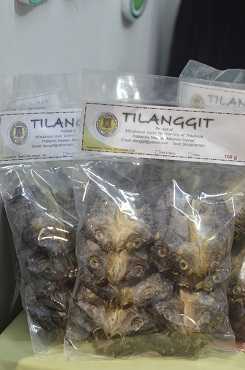 Dried squid and danggit are two of the popular and high-value processed fishery products patronized by Filipinos due to its distinct taste, aroma, and crispiness. But have you heard of this new product called tilanggit ?
Dried squid and danggit are two of the popular and high-value processed fishery products patronized by Filipinos due to its distinct taste, aroma, and crispiness. But have you heard of this new product called tilanggit ?
Tilanggit , also known as tilapiang dinanggit (Oreochromis niloticus ), was inspired from how the usual danggit (Rabbitfish), a famous fishery product from the Visayas. It is prepared similarly to danggit, which is horizontally cut into half and preserved through drying techniques. One of its distinct characteristics is it is more meaty as compared to danggit. Since the new product is seen having a huge economic potential, research and development initiatives are on track.
One of the agencies that ventured in this product breakthrough is the Bureau of Fisheries and Aquatic Resources-Regional Fisheries Research and Development Center 10 (BFAR–RFRDC 10) headed by Ms. Gigi C. Albor.
According to Mr. Vianney Anthony A. Gapuz, regional focal person for Community-based Participatory Action Research (CPAR) and OIC of Inland Resource and Management Sector of BFAR, the idea started during the Research Development and Extension (RDE) Review with Philippine Center for Aquatic and Marine Research and Development (PCMARRD) Zonal in 2005.
“The concept of tilanggit gave grounds in the region when BFAR embarked on producing tilapia for fillet,” Gapuz explained. Further, tilanggit is also developed in Region 10 as one of the components of an ongoing CPAR project on tilapia culture in Pangantucan, Bukidnon.
Gapuz also explained the selection process of tilapia for producing tilanggit . “As male tilapia grows faster and bigger than female tilapia, after segregation at 50-80 grams, the remaining female tilapia are processed into tilanggit , since only the male tilapia are cultured up to the desired harvest size of 250 – 450 grams,” he said.
Huge opportunities for tilanggit
Tilanggit production is seen by the region as good source of alternative livelihood. In fact, some fisherfolk associations and other individuals are starting to produce tilanggit . However, it is a seasonal activity because tilanggit production depends on the supply of quality tilapia. As of now, the common selling price is at 50 pesos per 100 gram and is bought through order basis.
In an effort to commercialize tilanggit through product development, RFRDC 10 is proposing a project under the National Technology Commercialization Program (NTCP) of Department of Agriculture-Bureau of Agricultural Research (DA-BAR). According to Mr. Gapuz, they have selected farmer cooperators for the project. Recently, RFRDC 10 started the promotion by featuring tilanggit during the 9th National Agriculture and Fisheries Technology Forum and Product Exhibition on 8-11 August 2013 at SM Megamall.
RFRDC 10 is eager in pursuing RDE through tilanggit commercialization to bring it from household to commercial level. “We need to develop tilanggit into a commercial product wherein it will be a regular demand in the grocery market,” Mr. Vianney Gapuz concluded. ###
Source: Liza Angelica D. Barral, Bar Chronicle August 2013 Issue (Vol. 14 No. 8)




Glad to know about the prospects of tilanggit production as I intend to go into this venture as a social enterprise after I retire from work in November next year. My sister has a one-hectare pond area in Pugol, Lamut, Ifugao that is currently for fresh tilapia production. Lamut is a tilapia producing municipality but it still has to develop value adding livelihood enterprise in the community.
Can you send a feasibility study on tilanggit production? Thanks already!